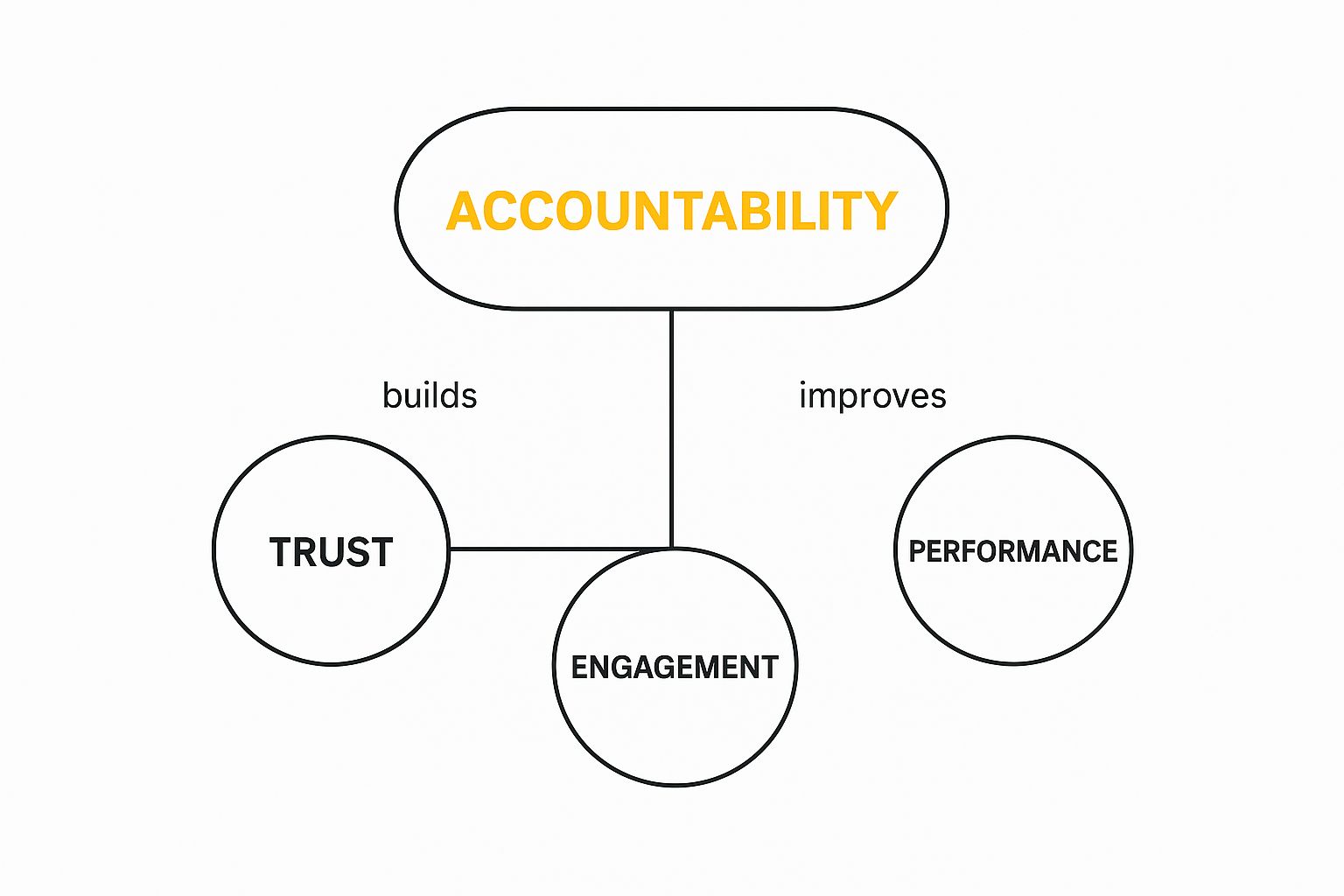When we talk about accountability in a team setting, we’re not just talking about who takes the fall when things go wrong. Forget that old-school, blame-centric mindset. True accountability is a shared commitment among team members to own their actions, their promises, and, most importantly, the collective results of their work.
This modern view shifts the focus from pointing fingers to mutual ownership. It’s about creating a culture where every single person is invested in the group’s success. Think of a high-performance pit crew—everyone’s actions are coordinated, interdependent, and aimed at a single goal. That’s the essence of what we’re aiming for.
This culture of mutual ownership is what transforms a group of individuals into a high-performing team. It’s not just a “soft skill”; it’s a powerful strategic advantage that directly fuels productivity, encourages innovation, and fosters a positive dynamic where people feel safe to contribute their best work.
The Clear Link Between Accountability and Engagement
Here’s a hard truth: where accountability is missing, engagement plummets. It’s a massive issue. Globally, only 23% of employees are engaged at work, while a staggering 62% are just going through the motions without any real commitment. This widespread disengagement costs the global economy an estimated $8.9 trillion in lost productivity.
But when you flip the script and foster accountability, the numbers tell a different story. Employees who feel accountable to their peers are 3.7 times more engaged and 68% less likely to experience burnout. If you’re curious, you can explore more employee engagement statistics for 2025 to see the full impact.
This concept map really brings the relationship to life:

As you can see, accountability isn’t just another buzzword. It’s the central driver that directly improves trust, performance, and engagement across the board.
Responsibility vs. Accountability: What’s the Difference?
People often use “responsibility” and “accountability” interchangeably, but in a team context, they mean very different things. Getting this distinction right is crucial for building a strong culture.
Responsibility is about doing the task. It’s the “who does what” on a project plan. Accountability, on the other hand, is about owning the outcome. It’s ensuring the task not only gets done but also achieves its intended goal.
Here’s a quick breakdown to make the distinction crystal clear:
Accountability vs. Responsibility At a Glance
| Aspect | Responsibility | Accountability |
|---|---|---|
| Focus | Task execution (the “doing”) | Outcome ownership (the “result”) |
| Scope | Individual actions and duties | The success or failure of the initiative |
| Nature | Can be shared among several people | Rests with one person for the final outcome |
| Example | “I’m responsible for writing the code.” | “I’m accountable for a bug-free launch.” |
Understanding this difference helps teams clarify expectations. While multiple people might be responsible for different parts of a project, a single person is ultimately accountable for its success. This clarity prevents things from falling through the cracks.
Shifting from a Culture of Blame to One of Ownership
One of the most common mistakes leaders make is using accountability as a hammer to assign fault when a project fails. This approach is toxic. It creates fear, discourages risk-taking, and makes people hide their mistakes.
True accountability is the exact opposite. It’s about building an environment where team members can openly discuss challenges and failures without fear of reprisal. It’s a forward-looking process focused entirely on learning and improvement, not punishment.
In a culture of accountability, the question shifts from “Who is to blame?” to “What can we learn from this, and how can we support each other to succeed next time?”
This shift is fundamental. It fosters what’s known as psychological safety—a state where individuals feel comfortable being transparent about their progress, admitting setbacks, and taking calculated risks. This open dialogue is the very bedrock upon which high-performing teams are built, leading to faster problem-solving and much stronger collaboration.
The Hidden Costs of Unclear Team Ownership

When projects go off the rails, leaders often look for complex reasons. But more often than not, the culprit is something deceptively simple: nobody truly owns the outcome. It’s a quiet problem that quickly spirals into confusion, finger-pointing, and a total breakdown in getting things done.
This is where accountability in teamwork stops being a corporate buzzword and becomes a critical survival tool.
Ever seen a task that everyone agrees is vital, yet it just sits there? That’s the classic “Bystander Effect” playing out in a business suit. When a task belongs to everyone, it effectively belongs to no one. Each person assumes someone else has it covered. The result is painfully predictable: the task gets done late, poorly, or not at all. Everyone saw it coming, but no one stepped up to stop it.
This isn’t just a minor snag. It’s a direct hit to your bottom line, creating wasted time, duplicated work, and endless project creep.
The Financial Drain of Ambiguity
The link between fuzzy roles and wasted cash is shockingly direct. When no one’s sure who’s responsible for what, collaboration grinds to a halt and hours evaporate into confusion. In fact, 64% of employees admit to wasting at least three hours a week because of poor collaboration, with a staggering 20% losing up to six hours weekly.
The chaos doesn’t stop there. Miscommunication alone is blamed for 28% of all missed deadlines. It gets even worse when you look at how teams work together—or don’t. A full 41% of employees say they struggle with cross-team collaboration, largely because organizational silos make it impossible to tell who is actually accountable. If you want to dig deeper, you can read more about these workplace collaboration findings and see the full picture.
This constant friction does more than just delay projects; it poisons the team’s culture.
When no one owns the outcome, everyone can deflect the blame. This cycle of finger-pointing creates a toxic environment where trust dies, and people become hesitant to take initiative, fearing they’ll be left holding the bag if things go south.
The tangible costs of this breakdown are serious and they stack up quickly. They include:
- Wasted Budgets: Money gets poured into fixing mistakes and making course corrections that clear ownership would have prevented from the very beginning.
- Sinking Morale: Even your most talented people will get frustrated and disengage when their best efforts are constantly undermined by chaos and a lack of direction.
- High Employee Turnover: Let’s be honest, top performers don’t stick around in chaotic environments. They leave for organizations where they know their work matters and is part of a clear, accountable process.
The only way to stop these costly and predictable failures is to build accountability directly into your team’s DNA. It’s how you turn ambiguity into clarity and transform potential chaos into focused, effective action.
How to Build a High-Accountability Culture

Let’s get one thing straight: building a culture of accountability isn’t about top-down enforcement or breathing down people’s necks. It’s about creating an environment where team members want to take ownership. This doesn’t just happen. It takes deliberate effort from everyone, and it all starts with radical clarity.
Think about it. If you were assembling furniture with vague, blurry instructions, you’d end up frustrated and with a wobbly table. The same goes for teamwork. Accountability is impossible when expectations are fuzzy. Your team needs to know, without a shadow of a doubt, what success looks like for every single task and project. That means defining deliverables, setting clear deadlines, and agreeing on quality standards right from the start.
This clarity goes beyond just the work itself; it’s baked into how you communicate. The connection between accountability in teamwork and communication is absolute. A staggering 86% of employees and executives point to ineffective collaboration as a key reason for workplace failures. While strong communication can boost productivity by 25%, it only works if clear accountability is part of the deal. Otherwise, you’re just talking in circles.
Cultivate Radical Transparency
With clear expectations set, transparency becomes the fuel for your accountability engine. This is all about making progress, roadblocks, and outcomes visible to everyone—not to micromanage, but to create a shared reality that keeps the whole team aligned and moving in the same direction.
When progress is out in the open, it naturally builds a sense of collective responsibility. People see how their piece of the puzzle fits into the bigger picture, which motivates them to follow through on their commitments. This visibility also acts as an early warning system, making it easy to spot and swarm a problem before it derails the entire project.
Transparency removes the fear of the unknown. When everyone can see where things stand, it’s easier to have honest conversations about what’s working and what isn’t, turning potential conflicts into opportunities for collaboration.
Foster Ownership from Day One
At its heart, true accountability is self-motivated. It’s that feeling of personal ownership over your work and its impact on the team. As a leader, you can’t just demand this—you have to cultivate it by giving your team autonomy and trusting them to get the job done.
Here’s how you can start building that sense of ownership:
- Delegate Outcomes, Not Tasks: Instead of dictating every single step, define the desired result and let your team figure out the best way to get there. This shows you trust their expertise and invites creative problem-solving.
- Connect Work to the Mission: Always draw a line from an individual’s daily tasks to the team’s bigger goals. A sense of purpose is an incredibly powerful motivator.
- Establish Constructive Feedback Loops: Create a safe space for regular, honest feedback. That means celebrating the wins just as much as you conduct blameless post-mortems when things go wrong, all in the spirit of learning and getting better together.
By embedding these principles into your team’s DNA, accountability becomes a natural outcome of a healthy, high-performing culture. A huge part of this is tracking the right things, and you can learn more by checking out our guide on how to measure team performance.
Practical Strategies to Drive Team Accountability
Theory is valuable, but action is what creates results. It’s one thing to understand accountability, but quite another to build it. To get there, you need practical, structured methods your team can put into practice right away. The real goal is to install systems that make ownership crystal clear and follow-through a natural part of your team’s workflow.
Think of these strategies less as quick fixes and more as foundational tools. They’re designed to transform your team’s day-to-day operations by focusing on proactive measures that snuff out confusion before it even starts. Let’s turn the abstract idea of accountability in teamwork into concrete, repeatable actions.
Create a Team Charter for Alignment
A Team Charter is a fantastic first step. Think of it as a constitution for your team, but one that’s created by the team itself. This document goes way beyond a simple project plan. It defines the team’s purpose, its core values, how it communicates, and how decisions get made.
By co-creating the charter, everyone establishes a shared understanding of how they’ll work together, hold each other to high standards, and handle conflicts with respect. This process builds immediate buy-in because it’s not a manager just dictating rules—it’s a collective agreement on what productive and accountable behavior actually looks like.
Implement Frameworks for Role Clarity
Ambiguity is the absolute enemy of accountability. Frameworks like DACI offer a simple but incredibly effective way to clarify who does what on any given project or decision. DACI stands for:
- Driver: The person responsible for corralling stakeholders and pushing the project forward.
- Approver: The one person who gets to make the final call.
- Contributors: People with expertise who provide input and recommendations.
- Informed: Individuals who just need to be kept in the loop on the outcome.
When you assign these roles right at the outset, you eliminate any confusion about ownership. Everyone knows their specific function, which keeps tasks from falling through the cracks and stops the dreaded “I thought you were handling that” problem dead in its tracks. To see more ways to structure your team’s work, you can explore other effective team collaboration strategies.
The most effective accountability tools are the ones that simplify complexity. A framework like DACI doesn’t add bureaucracy; it removes the friction caused by unclear roles, allowing the team to focus on execution instead of navigating internal confusion.
Conduct Blame-Free After-Action Reviews
If you want a culture of continuous improvement, your team has to be able to learn from both its wins and its losses. The After-Action Review (AAR) is a structured debrief designed to do exactly that, without pointing fingers. The whole process centers on four simple questions:
- What did we set out to do?
- What actually happened?
- Why did it happen?
- What will we do differently next time?
This blame-free approach encourages honesty and psychological safety. It shifts the focus from finding individual fault to fostering collective learning. This reinforces the idea that the entire team is accountable for improving its processes and outcomes over time. When you do them consistently, AARs turn every single project into a valuable lesson.
Using Technology to Reinforce Accountability

When your team is spread out across different locations or juggling hybrid schedules, the old “hallway conversation” method for tracking progress just doesn’t cut it. Commitments get lost in the shuffle, ambiguity creeps in, and deadlines start slipping. This is where modern digital tools become your best friend, creating a single, accessible source of truth that reinforces accountability in teamwork.
Let’s be clear: this isn’t about micromanagement. It’s about providing the clear structure everyone needs to take ownership. When roles and responsibilities are out in the open for everyone to see, it creates a powerful, positive kind of peer pressure. That visibility is a game-changer; one study found that teams with high role clarity are 53% more efficient, simply because there’s no confusion over who owns what.
Creating a Central Hub for Commitments
The best tools for accountability work by pulling everything into one place and killing ambiguity for good. They take critical updates out of scattered email threads and private DMs and put them into a shared space where progress is completely transparent. This is exactly what platforms like NASA – Not Another Standup App are built to do.
By their very nature, these apps provide a ready-made framework for consistent check-ins and progress updates. They help teams:
- Establish a single source of truth so there’s never a question about project status or individual commitments. Everyone is looking at the same dashboard.
- Make progress visible by tracking tasks from the moment they’re assigned to the moment they’re done. Nothing falls through the cracks.
- Clarify ownership by making it crystal clear who is responsible for each task and goal.
The right toolset is also a massive help for improving meeting quality—another area where accountability can easily fall apart. If you’re looking to make your syncs more productive, you should check out these tips to improve meeting effectiveness.
Ultimately, it comes down to a simple human truth: when people know what’s expected of them and can see how their work connects to the team’s larger goals, they are far more motivated to follow through. Technology simply provides the scaffolding to support that culture, baking accountability right into your team’s daily rhythm.
Your Path to Lasting Team Accountability
True accountability isn’t some checkbox you tick or a destination you finally arrive at. Think of it more like a muscle—it needs to be exercised every single day to grow stronger. Building it means ditching the quick fixes and really embedding a sense of ownership into your team’s DNA.
We’ve walked through a few core pillars that this journey rests on. First, there’s the non-negotiable need for clarity. When everyone knows exactly what’s expected of them, what their role is, and what the goal is, accountability has fertile ground to grow. Then comes ownership, which is all about empowering your team to drive outcomes, not just check off tasks. Finally, you need the right systems and tools in place to make progress visible and follow-through feel like a natural part of the workflow.
The goal here isn’t just about hitting deadlines or finishing projects. It’s about creating a resilient, engaged, and psychologically safe environment where your team can consistently do its best work.
Your First Steps Forward
You don’t have to blow up your entire workflow overnight. Real, lasting change always starts small. Just pick one or two of the strategies we’ve talked about and commit to them.
- Start with a Team Charter: Carve out time in one meeting to create a simple document together that outlines how you’ll work as a team. This single act is fantastic for building immediate buy-in.
- Clarify Roles on One Project: Try using a framework like DACI for your next big initiative. Seeing the confusion melt away is a powerful motivator to keep going.
- Conduct One Blame-Free Review: After a project wraps up, get together and ask: What went well? What didn’t? What will we do differently next time? The focus is 100% on learning, not pointing fingers.
When you start small, you build momentum. As these new habits take root, you’ll notice a real difference not just in your results, but in team morale and collaboration. This foundation is crucial, and if you’re looking for more ideas, you can explore our other guides on how to improve team productivity.
Ultimately, lasting accountability in teamwork delivers more than just efficiency—it builds trust, sparks innovation, and gives your team the confidence to tackle any challenge that comes their way.
Common Questions About Team Accountability
Even with a solid plan, you’re bound to hit a few tricky spots when you start building a culture of accountability. It’s totally normal. Let’s walk through some of the most common questions and challenges that pop up so you can handle them with confidence.
How Do You Handle Resistance from the Team?
First off, expect some resistance. If your team is used to a culture where accountability was either missing or, worse, used as a way to point fingers, they’ll naturally be skeptical. The trick is to reframe accountability not as a top-down rule, but as a mutual agreement to make your work lives better.
A great starting point is to create a Team Charter together. When people get a say in setting the ground rules, that initial resistance often melts into a sense of ownership. Frame the conversation around the benefits for them—less chaos, fewer frustrating bottlenecks, and that awesome feeling of achieving something big as a unit.
The goal isn’t to force compliance but to build genuine buy-in. Demonstrate how accountability makes everyone’s job easier and more rewarding, and most people will come around.
Is Accountability Different for Remote Teams?
The core principles don’t change, but how you execute them has to be far more intentional. When you’re working remotely or in a hybrid model, you can’t just rely on seeing people at their desks to feel aligned. This is where visible, digital systems for tracking work and commitments become non-negotiable.
For remote teams, real accountability needs:
- Extreme Clarity: You have to over-communicate everything—expectations for tasks, deadlines, even general availability. Make shared documents your single source of truth.
- Visible Progress: Use tools that make everyone’s progress transparent. This is the digital substitute for the ambient awareness you get in a physical office.
- Structured Check-ins: Things like daily async stand-ups are perfect for keeping everyone on the same page without piling on more video meetings.
How Do You Give Feedback Without Sounding Critical?
This is a big one. Getting feedback right is absolutely essential for maintaining psychological safety. The best way to do this is to make feedback a regular, normal part of your process—not a scary event that only happens when something has gone wrong.
Always focus on the work or the behavior, never the person. A simple “Situation-Behavior-Impact” framework works wonders. For instance, instead of saying, “You were late with your report,” you could try, “When the report was delayed (situation), the marketing team couldn’t start their part (impact).” It keeps the conversation objective and shifts the focus to solving the problem together. It’s also important to have the right systems in place, and for companies using Jira, it’s useful to learn about use cases for a multilingual service desk to support diverse teams.
Ready to build unbreakable accountability into your team’s workflow? NASA – Not Another Standup App provides the structure and visibility you need to keep everyone aligned and focused.
